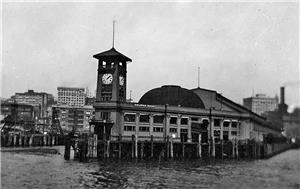The Beezer Brothers (1908-1923 in Seattle), a firm headed by twins Louis Beezer (1869-1929) and Michael J. Beezer (1869-1933), was a Seattle architectural firm with many commissions across Washington state, most notably in Walla Walla. This well-managed partnership is best known for its architectural contributions to the Catholic community of Seattle and Washington state. One of their buildings, Edward J. O'Dea High School (1923-24), located at 802 Terry Avenue, is a significant, extant example of the Gothic Revival style in Seattle. In Walla Walla, the Baker Boyer Building was that city's first skyscraper, and the First National Bank of Walla Walla (now First Federal Savings Bank) is considered their bank masterpiece.
Brothers from Pennsylvania
Born on July 6, 1869 in Bellefonte, Pennsylvania, Louis and Michael Beezer came to architecture early in their closely connected lives. Work with a construction business introduced Louis to architecture; by age 21 he was a building foreman in Altoona, Pennsylania. Louis returned to Altoona after a few years of architectural study in Pittsburgh. In 1892, he and his brother Michael began their three-decade partnership. From 1900 to 1907, before their arrival in Seattle, the brothers designed a number of Pittsburgh churches and houses. Their Seattle business thrived immediately upon their arrival in 1907; this probably resulted from the team’s management practices.
The Beezer Brothers actively supervised building sites, acting as construction managers as well as architects for their far flung commissions. At their firm’s height, these commissions extended as far north as Alaska, and as far south as Hollywood, California. As construction managers, the Beezer Brothers oversaw daily, on-site, work activities. Usually this work is contracted to construction firms. Soon after their arrival in Seattle, the brothers received a locally significant project, designing Colman Dock (1908-1909), the new steamship terminal. Other early commissions included:
- The Oliver D. Fisher house (1908-1909) on southwest Capitol Hill;
- The Homer L. Hillman house (1908-1909) on southwest Capitol Hill;
- The Leary Building (later the Insurance Building, 1906-1910, destroyed) downtown Seattle;
- An apartment building for Mr. and Mrs. John B. Beltinck (1908-1909) located at 319 16th Avenue.
The Beezer Brothers were best known for projects associated with the local Roman Catholic diocese, which was located in Seattle after 1903. These commissions included:
- The Immaculate Conception School (1909-1910) at 810 18th Avenue;
- The Blessed Sacrament Church (1909-1911, 1922-1925) at 5049 9th Avenue NE;
- The Immaculate Conception rectory (1910-1914) at 820 18th Avenue;
- The Cathedral School (1911-1912) at 803 Terry Avenue; Our Lady of Mount Virgin Church (1915) at 1531 Bradner Place S;
- The Society of Jesus rectory (1919-1921) at 730 18th Avenue E;
- Saint Joseph School (1922-1923) at 720 18th Avenue.
Their design and construction work for the Saint Mary Hospital (1909-1916, Walla Walla, destroyed) sparked the team’s expansion beyond Seattle. Throughout their careers, the brothers produced a number of competent bank designs, while continuing their focus on Roman Catholic project work. The Beezer Brothers rarely deviated from these two areas of expertise.
From 1923 until his death in 1929, Louis operated a branch practice in San Francisco. The Saint Dominic Catholic Church (1923-1929) played a part in this separation. Louis Beezer later designed the Church of the Blessed Sacrament (1926-1929) in Hollywood, California, reportedly the second largest church on the West Coast. The Seattle office suffered from Louis’s departure, however, producing little noteworthy work before Michael’s retirement in 1932.
The work of the Beezer Brothers reflected their personal beliefs; both Louis and Michael were devout Catholics. These beliefs, coupled with a steadfast work ethic, helped the brothers shape the physical identity of Seattle and local Catholic communities.

